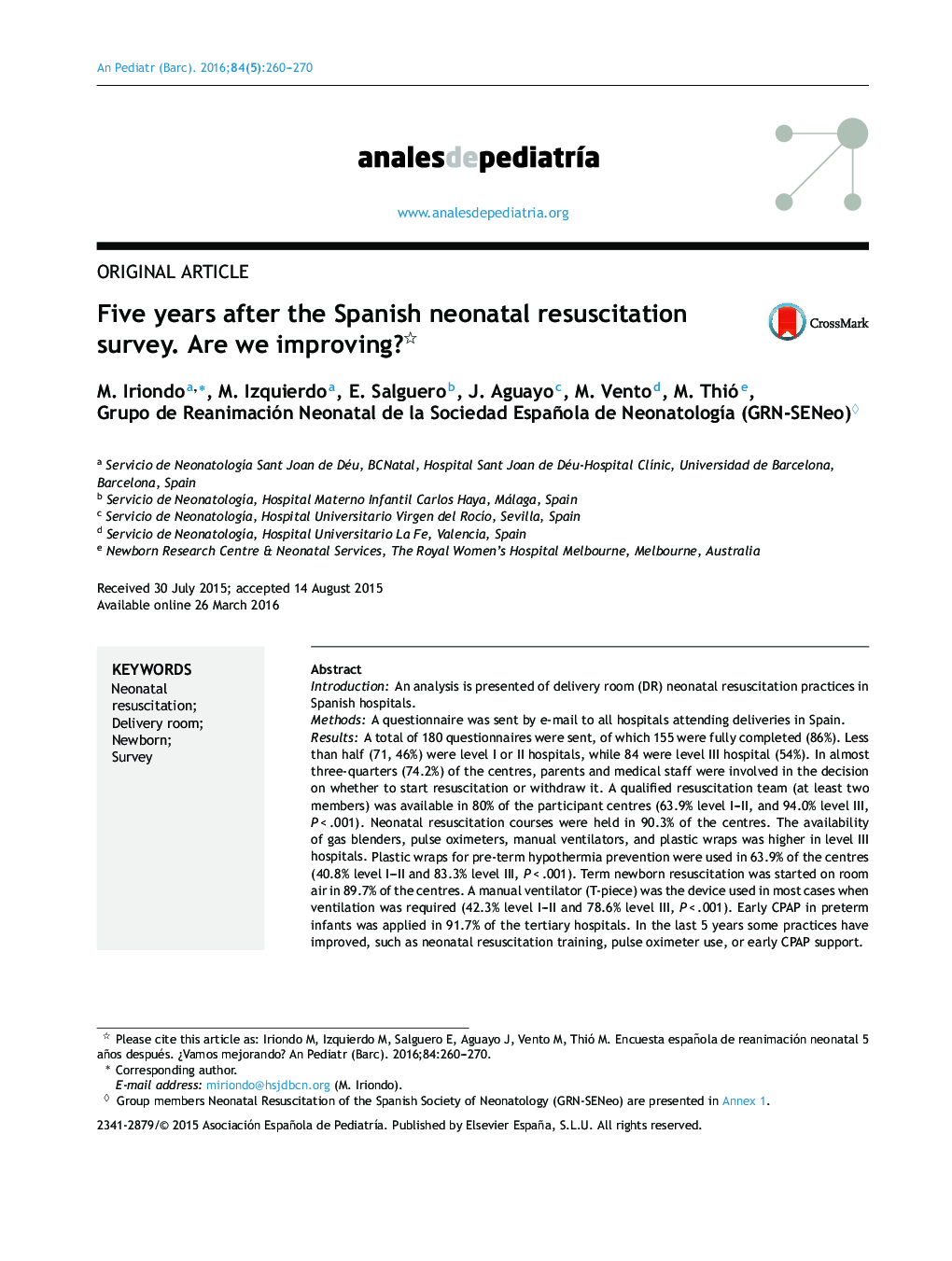| کد مقاله | کد نشریه | سال انتشار | مقاله انگلیسی | نسخه تمام متن |
|---|---|---|---|---|
| 4145045 | 1272583 | 2016 | 11 صفحه PDF | دانلود رایگان |
IntroductionAn analysis is presented of delivery room (DR) neonatal resuscitation practices in Spanish hospitals.MethodsA questionnaire was sent by e-mail to all hospitals attending deliveries in Spain.ResultsA total of 180 questionnaires were sent, of which 155 were fully completed (86%). Less than half (71, 46%) were level I or II hospitals, while 84 were level III hospital (54%). In almost three-quarters (74.2%) of the centres, parents and medical staff were involved in the decision on whether to start resuscitation or withdraw it. A qualified resuscitation team (at least two members) was available in 80% of the participant centres (63.9% level I–II, and 94.0% level III, P < .001). Neonatal resuscitation courses were held in 90.3% of the centres. The availability of gas blenders, pulse oximeters, manual ventilators, and plastic wraps was higher in level III hospitals. Plastic wraps for pre-term hypothermia prevention were used in 63.9% of the centres (40.8% level I–II and 83.3% level III, P < .001). Term newborn resuscitation was started on room air in 89.7% of the centres. A manual ventilator (T-piece) was the device used in most cases when ventilation was required (42.3% level I–II and 78.6% level III, P < .001). Early CPAP in preterm infants was applied in 91.7% of the tertiary hospitals. In the last 5 years some practices have improved, such as neonatal resuscitation training, pulse oximeter use, or early CPAP support.ConclusionsThere is an improvement in some practices of neonatal resuscitation. Significant differences have been found regarding the equipment or practices in the DR, when comparing hospitals of different levels of care.
ResumenIntroducciónSe analizan prácticas de reanimación neonatal en salas de partos (SP) de centros hospitalarios españoles.MétodosSe envió un cuestionario por centro a neonatólogos responsables de la atención del RN en SP de hospitales españoles.ResultadosDe 180 cuestionarios enviados, se cumplimentaron 155 (86%); 71 centros fueron de nivel I-II (46%) y 84 de nivel III (54%). La familia y el equipo médico participaron en decisiones de no reanimar o interrumpir la reanimación en el 74,2% de los centros. La disponibilidad de 2 o más reanimadores fue del 80% (94,0% en nivel II I y 63,9% en nivel I-II, p < 0,001). En un 90,3% de centros se realizan cursos de Reanimación. En centros de nivel III fueron más frecuentes los mezcladores de gases, pulsioxímetros, ventiladores manuales y envoltorios de plástico. El uso de envoltorios de polietileno fue del 63,9%. En RN a término se inició la reanimación con aire en el 89,7% de los centros. El dispositivo más usado para aplicar VPP fue el «ventilador manual» (78,6% en nivel III y 42,3% en nivel I-II, p < 0,001). En el 91,7% de los centros de nivel III se utilizó CPAP precoz en prematuros. En los últimos 5 años han mejorado prácticas como son la formación de profesionales, el uso de pulsioxímetros y de CPAP precoz.ConclusionesExiste una mejora progresiva en algunas prácticas de reanimación neonatal. Se encuentran diferencias en aspectos generales, equipamientos y protocolos de actuación durante la reanimación y transporte entre unidades de diferentes niveles.
Journal: Anales de Pediatría (English Edition) - Volume 84, Issue 5, May 2016, Pages 260–270
